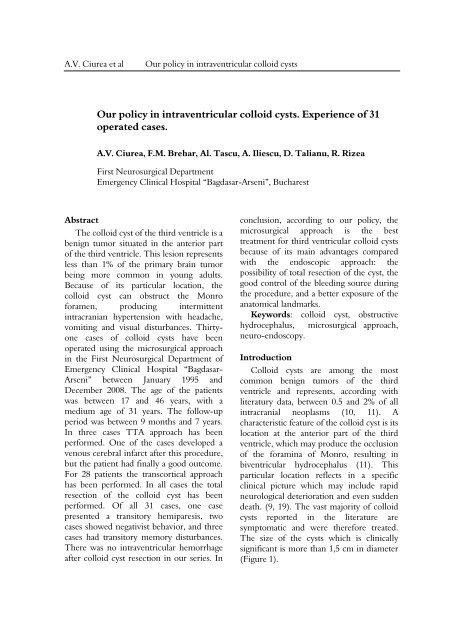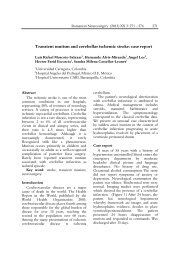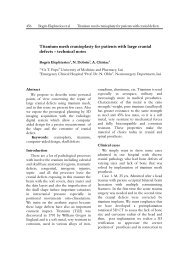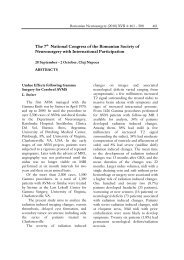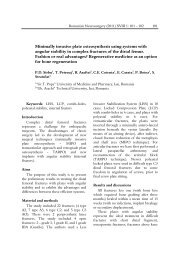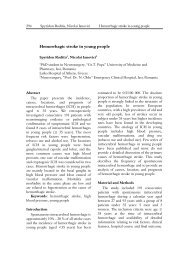Our policy in intraventricular colloid cysts. Experience of 31 operated ...
Our policy in intraventricular colloid cysts. Experience of 31 operated ...
Our policy in intraventricular colloid cysts. Experience of 31 operated ...
Create successful ePaper yourself
Turn your PDF publications into a flip-book with our unique Google optimized e-Paper software.
A.V. Ciurea et al<strong>Our</strong> <strong>policy</strong> <strong>in</strong> <strong>in</strong>traventricular <strong>colloid</strong> <strong>cysts</strong><strong>Our</strong> <strong>policy</strong> <strong>in</strong> <strong>in</strong>traventricular <strong>colloid</strong> <strong>cysts</strong>. <strong>Experience</strong> <strong>of</strong> <strong>31</strong><strong>operated</strong> cases.A.V. Ciurea, F.M. Brehar, Al. Tascu, A. Iliescu, D. Talianu, R. RizeaFirst Neurosurgical DepartmentEmergency Cl<strong>in</strong>ical Hospital “Bagdasar-Arseni”, BucharestAbstractThe <strong>colloid</strong> cyst <strong>of</strong> the third ventricle is abenign tumor situated <strong>in</strong> the anterior part<strong>of</strong> the third ventricle. This lesion representsless than 1% <strong>of</strong> the primary bra<strong>in</strong> tumorbe<strong>in</strong>g more common <strong>in</strong> young adults.Because <strong>of</strong> its particular location, the<strong>colloid</strong> cyst can obstruct the Monr<strong>of</strong>oramen, produc<strong>in</strong>g <strong>in</strong>termittent<strong>in</strong>tracranian hypertension with headache,vomit<strong>in</strong>g and visual disturbances. Thirtyonecases <strong>of</strong> <strong>colloid</strong> <strong>cysts</strong> have been<strong>operated</strong> us<strong>in</strong>g the microsurgical approach<strong>in</strong> the First Neurosurgical Department <strong>of</strong>Emergency Cl<strong>in</strong>ical Hospital “Bagdasar-Arseni” between January 1995 andDecember 2008. The age <strong>of</strong> the patientswas between 17 and 46 years, with amedium age <strong>of</strong> <strong>31</strong> years. The follow-upperiod was between 9 months and 7 years.In three cases TTA approach has beenperformed. One <strong>of</strong> the cases developed avenous cerebral <strong>in</strong>farct after this procedure,but the patient had f<strong>in</strong>ally a good outcome.For 28 patients the transcortical approachhas been performed. In all cases the totalresection <strong>of</strong> the <strong>colloid</strong> cyst has beenperformed. Of all <strong>31</strong> cases, one casepresented a transitory hemiparesis, twocases showed negativist behavior, and threecases had transitory memory disturbances.There was no <strong>in</strong>traventricular hemorrhageafter <strong>colloid</strong> cyst resection <strong>in</strong> our series. Inconclusion, accord<strong>in</strong>g to our <strong>policy</strong>, themicrosurgical approach is the besttreatment for third ventricular <strong>colloid</strong> <strong>cysts</strong>because <strong>of</strong> its ma<strong>in</strong> advantages comparedwith the endoscopic approach: thepossibility <strong>of</strong> total resection <strong>of</strong> the cyst, thegood control <strong>of</strong> the bleed<strong>in</strong>g source dur<strong>in</strong>gthe procedure, and a better exposure <strong>of</strong> theanatomical landmarks.Keywords: <strong>colloid</strong> cyst, obstructivehydrocephalus, microsurgical approach,neuro-endoscopy.IntroductionColloid <strong>cysts</strong> are among the mostcommon benign tumors <strong>of</strong> the thirdventricle and represents, accord<strong>in</strong>g withliteratury data, between 0.5 and 2% <strong>of</strong> all<strong>in</strong>tracranial neoplasms (10, 11). Acharacteristic feature <strong>of</strong> the <strong>colloid</strong> cyst is itslocation at the anterior part <strong>of</strong> the thirdventricle, which may produce the occlusion<strong>of</strong> the foram<strong>in</strong>a <strong>of</strong> Monro, result<strong>in</strong>g <strong>in</strong>biventricular hydrocephalus (11). Thisparticular location reflects <strong>in</strong> a specificcl<strong>in</strong>ical picture which may <strong>in</strong>clude rapidneurological deterioration and even suddendeath. (9, 19). The vast majority <strong>of</strong> <strong>colloid</strong><strong>cysts</strong> reported <strong>in</strong> the literature aresymptomatic and were therefore treated.The size <strong>of</strong> the <strong>cysts</strong> which is cl<strong>in</strong>icallysignificant is more than 1,5 cm <strong>in</strong> diameter(Figure 1).
Romanian Neurosurgery (2011)Figure 1 MRI aspect <strong>of</strong> the <strong>colloid</strong> cyst <strong>of</strong> the thirdventricleFigure 2 CT scan show<strong>in</strong>g <strong>colloid</strong> cyst located <strong>in</strong>third ventricle with obstructive hydrocephalusThe ma<strong>in</strong> symptoms <strong>of</strong> the <strong>colloid</strong> <strong>cysts</strong>are: headache, gait disturbances, disturbedmentation, vomit<strong>in</strong>g, blurred vision,<strong>in</strong>cont<strong>in</strong>ence and dizz<strong>in</strong>ess. The ma<strong>in</strong> signsare papilledema, gait disturbance,hyperreflexia, <strong>in</strong>coord<strong>in</strong>ation and nistagmus(10) The treatment <strong>of</strong> asymptomatic <strong>colloid</strong><strong>cysts</strong> depends on <strong>in</strong>dividual characteristicsand patients’options (12, 13). The majorsymptoms depend <strong>of</strong> the size <strong>of</strong> the <strong>colloid</strong><strong>cysts</strong> and are usually related to thesecondary hydrocephalus produced whenthey are large enough to occlude the Monr<strong>of</strong>oramen (Figure 2). Signs and symptomsmay be also produced by compression <strong>of</strong>the nearby structures, like hypothalamusfloor and fornix. Sjovall et al postulated 100years ago, that episodic <strong>in</strong>tracranialhypertension crises could be produces by<strong>in</strong>termitent obstruction <strong>of</strong> Monro foramen(20). Sudden <strong>in</strong>creased <strong>in</strong> size <strong>of</strong> the <strong>colloid</strong>cyst due to <strong>in</strong>tracystic hemmorhage couldbe another mechanism which expla<strong>in</strong> theneurological deficits (1).Despite several cases which presentedseveral neurological deficits related to thesize <strong>of</strong> the cyst, sudden deterioration is rarefor the most patients with <strong>colloid</strong> <strong>cysts</strong>, andthe first symptoms are <strong>in</strong>termittent andnonspecific. (3). The cause <strong>of</strong> thesedeterioration is usually related to theobstruction <strong>of</strong> CSF outflow due toparticular location <strong>of</strong> the cyst. Otherauthors suggested that sudden death isrelated rather to local compression <strong>of</strong> thewall <strong>of</strong> the third ventricle, thuscompromis<strong>in</strong>g cardiovascular regulatorycenters <strong>in</strong> the hypothalamus, than withacute obstructive hydrocephalus (16).Probably, keep<strong>in</strong>g <strong>in</strong> m<strong>in</strong>d both hypothesismentioned above, the mechanism <strong>in</strong> suchcases is multifactorial (6). In cases withobstructive hydrocephalus, acute
deterioration might be provoked by lumbarpuncture, therefore a CT scan is mandatorybefore perform<strong>in</strong>g such a procedure (3). Inthe presence <strong>of</strong> associated obstructivehydrocephalus, there are two managemntoptions. If there is an acute symptomatichydrocephalus, a ventricular dra<strong>in</strong>ageshould be performed <strong>in</strong> emergency. If theventricular enlargment is not accompaniedby s<strong>in</strong>gs and symptoms <strong>of</strong> <strong>in</strong>tracranialhypertension, the presence <strong>of</strong>hydrocephalus ventricles could beadvantageous, <strong>of</strong>fer<strong>in</strong>g to the surgeon anatural corridor and enough room to reachthe cyst and to remove the lesion. Thissituation is favorable for the transcorticalapproach. Contrary, if the transcallosalroute is chosen, one way is to implant aventricular dra<strong>in</strong> <strong>in</strong> order to avoid excessiveretraction <strong>of</strong> the medial wall <strong>of</strong> the frontallobe (11). In this paper the authors presenttheir experience <strong>in</strong> <strong>31</strong> consecutive cases <strong>of</strong><strong>colloid</strong> <strong>cysts</strong> <strong>operated</strong> us<strong>in</strong>g twomicrosurgical approaches.Materials and methodsThirty one cases <strong>of</strong> <strong>colloid</strong> <strong>cysts</strong> havebeen <strong>operated</strong> us<strong>in</strong>g the microsurgicalapproach <strong>in</strong> the First NeurosurgicalDepartment between January 1995 andDecember 2008. The age <strong>of</strong> the patientswas between 17 and 46 years, with amedium age <strong>of</strong> <strong>31</strong> years. There were 15males and 16 females. The ma<strong>in</strong> symptomswere: headache <strong>in</strong> 28 cases (90,3%), ataxia<strong>in</strong>12 cases (38,7%), VI-th nerve paresis <strong>in</strong> 9cases (29,1%), memory impairment <strong>in</strong> 14cases (45,2%), “ventricular seizures” <strong>in</strong> 18cases (58,1%). Other cl<strong>in</strong>ical signs consist <strong>in</strong>gatism <strong>in</strong> 4 cases (12,9%), nystagmus <strong>in</strong> 5cases (16,1%), bilateral dismetria <strong>in</strong> 4 cases(12,9%), epileptic seizures <strong>in</strong> 11 cases(35,5%), psychic impairment <strong>in</strong> 5 cases(16,1%). Twenty-eight cases (90,4%) havepreoperative hydrocephalus and 3 cases(9,6%) were without hydrocephalus Thefollow-up period was between 9 monthsand 7 years. One case died <strong>in</strong> theemergency room and diagnosis has beenestablished dur<strong>in</strong>g necropsy (case non<strong>in</strong>cluded<strong>in</strong> our series). Another casepresented at the emergency room with<strong>in</strong>tracranial hypertension syndrome. TheCT scan showed signs <strong>of</strong> acutehydrocephalus. VP shunt has beenperformed <strong>in</strong> emergency and the patient’ssymptoms improved significantly. The MRperformed after surgical procedureidentified a <strong>colloid</strong> cyst located <strong>in</strong> the thirdventricle which had produced theobstructive hydrocephalus.Treatment consisted <strong>in</strong> surgery <strong>in</strong> <strong>31</strong>cases (100%), respectively <strong>in</strong> tumourremoval without VP shunt 29 cases(93,5%) and VP shunt (performed <strong>in</strong>emergency) and removal <strong>of</strong> the tumor <strong>in</strong> 2cases (6,50%). There was no case forobservation only.In three cases, TTA approach has beenperformed. One <strong>of</strong> the cases developed avenous cerebral <strong>in</strong>farct after this procedure,but the patient had f<strong>in</strong>ally a good outcome.For 28 patients, the transcorticalapproach has been performed. Theadvantages <strong>of</strong> this approach consist <strong>in</strong> theexcellent exposure <strong>of</strong> the cyst andsurround<strong>in</strong>g important anatomicallandmarks (<strong>in</strong>ternal cerebral ve<strong>in</strong>, anteriorseptal ve<strong>in</strong>, talamo-striate ve<strong>in</strong>, choroidplexus, etc.), the resection <strong>of</strong> the cyst totally<strong>in</strong>clusive the cyst’s capsule and a very goodcontrol <strong>of</strong> any bleed<strong>in</strong>g po<strong>in</strong>t.Results and discussionsIn all cases total removal <strong>of</strong> the <strong>colloid</strong>cyst has been performed (Figure 3 andFigure 4).
Romanian Neurosurgery (2011)Figure 3AFigure 4AFigure 3A Colloid cyst <strong>of</strong> the third ventricle.B Postoperative aspectOf all <strong>31</strong> cases, one case presented atransitory hemiparesis, two cases showednegativist behavior, and three cases hadtransitory memory disturbances. There wasno <strong>in</strong>traventricular hemorrhage after <strong>colloid</strong>cyst resection <strong>in</strong> our series. Immediatecomplications consist <strong>in</strong> <strong>in</strong>tracerebralhemorrhage 1 case (3,2%), epileptic seizures<strong>in</strong> 11 cases (35,4%), <strong>of</strong> which partialseizures <strong>in</strong> 7 cases (22,5%) and generalizedseizures <strong>in</strong> 4 cases (12,9%).Figure 4A Colloid cyst <strong>of</strong> the third ventricle.B Postoperative MR image which shows totalresection <strong>of</strong> the cystLate complications were: obstructivehydrocephalus <strong>in</strong> 2 cases (6,4%), transitoryleft hemiparesis <strong>in</strong> 5 cases (16,1%), memorydisorder <strong>in</strong> 8 cases (25,8%), negativism,apathy <strong>in</strong> 4 cases (12,9%).Evolution <strong>of</strong> <strong>31</strong> cases <strong>operated</strong> werefavorable <strong>in</strong> 30 cases (96,7%), worse <strong>in</strong> 1case (3,3%) and no case <strong>of</strong> death (0 %).Microsurgical approach should be thefirst treatment option. Either transverstranscallosal approach (TTA), or
transcortical approach could be used toreach and resect the lesion totally.Both approaches are effective andusually safe, although neither is withoutcomplications. The <strong>in</strong>itial steps <strong>of</strong> thetranscallosal are perhaps a bit more difficultand require meticulous microsurgicaltechniques. We do not prefer it, howeverthis is the procedure <strong>of</strong> choice if ventriclesare not enlarged. It allows a goodvisualization <strong>of</strong> the structures <strong>in</strong>side theventricular system. On the other hand thetrancortical approach have severaladvantages compared with transverstranscallosal approach.The m<strong>in</strong>im <strong>in</strong>vasive techniques consist<strong>in</strong> endoscopic, endoscope-assisted keyholeapproaches and, less frequently nowadays,stereotactic aspiration <strong>of</strong> the cyst. Colloid<strong>cysts</strong>, especially <strong>in</strong> patients with normalventricles after shunt<strong>in</strong>g, can be treatedwith simple stereotactic aspiration (2). Itshould be mentioned that the content couldbe too viscous and difficult to aspirate (15)and, furthermore, part <strong>of</strong> the capsule maybe left beh<strong>in</strong>d, caus<strong>in</strong>g recurrence <strong>of</strong> thelesion <strong>in</strong> an unacceptably high rate (8).More recently, endoscopic approachrepresents reasonable alternatives.However, there are many cases whenportions <strong>of</strong> the capsule are left beh<strong>in</strong>d sothe risk <strong>of</strong> recurrence still rema<strong>in</strong>s. Despite<strong>of</strong> the technological advances, questionsstill rema<strong>in</strong> regard<strong>in</strong>g the advantages <strong>of</strong>open versus endoscopic <strong>in</strong> resection <strong>of</strong><strong>colloid</strong> <strong>cysts</strong>. Compar<strong>in</strong>g a series <strong>of</strong> a s<strong>in</strong>gle<strong>in</strong>stitution, Horn et al. showed that <strong>in</strong> theendoscopic group the rate <strong>of</strong> residual orrecurrent <strong>cysts</strong> was higher and the length <strong>of</strong>stay was slightly shorter (7). This studyshowed also, that severe complications suchas hemiparesis and memory deficits can beassociated with this m<strong>in</strong>imal <strong>in</strong>vasiveapproach. Before the recent development <strong>of</strong>modern endoscopic technique, Kelly et alproposed another m<strong>in</strong>imally <strong>in</strong>vasiveapproach which consisted <strong>in</strong> plac<strong>in</strong>gstereotactically a tube retractor through afrontal burr hole. Other authors supportthe simultaneous approach <strong>of</strong> endoscopicand microsurgical strategies (4). Asmentioned above, ventricular enlargementcould be advantageous for the surgicalapproach, especially for transcorticalapproach. Contrary, if the transcallosalroute is chosen, a ventricular dra<strong>in</strong> shouldbe used <strong>in</strong>tra-operatively <strong>in</strong> order to avoidexcessive retraction <strong>of</strong> the medial wall <strong>of</strong>the frontal lobe (11). Several authors whosupport the microsurgical approach <strong>of</strong> the<strong>colloid</strong> cyst <strong>of</strong> the third ventricle as the besttherapeutically option (5, 14, and 18). M.Sami consider also that third ventricle<strong>colloid</strong> cyst has a perfect microsurgical<strong>in</strong>dication (17). In our op<strong>in</strong>ion themicrosurgical approach is the besttreatment for third ventricular <strong>colloid</strong> <strong>cysts</strong>because it <strong>of</strong>fers several advantagescompared with the endoscopic approach,such as the possibility <strong>of</strong> total resection <strong>of</strong>the cyst, the good control <strong>of</strong> the bleed<strong>in</strong>gsource dur<strong>in</strong>g the procedure, and a betterexposure <strong>of</strong> the anatomical landmarks. <strong>Our</strong>option is for the transcortical microsurgicalapproach because TTA has and importantrisk <strong>of</strong> memory deficit and could producedeep ve<strong>in</strong> lesions.The advantages <strong>of</strong> this approach consist<strong>in</strong> the excellent exposure <strong>of</strong> the cyst andsurround<strong>in</strong>g important anatomicallandmarks (<strong>in</strong>ternal cerebral ve<strong>in</strong>, anteriorseptal ve<strong>in</strong>, talamo-striate ve<strong>in</strong>, choroidplexus, etc.), the resection <strong>of</strong> the cyst totally<strong>in</strong>clusive the cyst’s capsule and a very goodcontrol <strong>of</strong> any bleed<strong>in</strong>g po<strong>in</strong>t.
Romanian Neurosurgery (2011)ConclusionColloid <strong>cysts</strong> are rare benign lesionslocated <strong>in</strong> the anterior part <strong>of</strong> the 3rdventricle <strong>in</strong> Monro area. The patognomonicfeatures are <strong>in</strong>tracranial hypertensionattacks and so called “ventricular seizures”.The presence <strong>of</strong> <strong>in</strong>tracranial hypertensionrequires surgery <strong>in</strong> emergency. Inconclusion, we th<strong>in</strong>k the microsurgicalapproach is the best treatment for thirdventricular <strong>colloid</strong> <strong>cysts</strong> because <strong>of</strong> its ma<strong>in</strong>advantages compared with the endoscopicapproach: the possibility <strong>of</strong> total resection<strong>of</strong> the cyst, the good control <strong>of</strong> the bleed<strong>in</strong>gsource dur<strong>in</strong>g the procedure, and a betterexposure <strong>of</strong> the anatomical landmarks.Microsurgical approach should be the firsttreatment option. Either transverstranscallosal approach (TTA), ortrancortical approach could be used to reachand resect the lesion totally.e-mail: felixbrehar@yahoo.comtel: +40213343025AbbreviationsCSF: cerebro-sp<strong>in</strong>al fluid; TTA:transvers transcallosal approach; VP:Ventriculo-peritonealReferences1. Beems T, Menovsky T, Lammens M (2006)Hemorrhagic <strong>colloid</strong> cyst. Case report and review <strong>of</strong> theliterature. Surg Neurol 65: 84-862. Bosch D A, Rahn T, Backlund E O: Treatment <strong>of</strong><strong>colloid</strong> cyst <strong>of</strong> the third ventricle by stereotacticaspiration, Surg. Neurol. 9: 15-8, 19783. Buttner A, W<strong>in</strong>kler PA, Eisenmenger W, Weis W(1997) Colloid cyst <strong>of</strong> the third ventricle with fataloutcome: a report <strong>of</strong> two cases and review <strong>of</strong> theliterature. Int J Legal Med 110: 260-2664. Charampaki P, Filippi R, Welschehold S, et al. (2005)Tumors <strong>of</strong> the lateral and third ventricle: removal underendoscope – assisted keyhole conditions. Neurosurgery57 (ONS Suppl 4): ONS-302-ONS-<strong>31</strong>15. Ciurea A.V., Al. Tascu, F. Brehar, R. Rizea,Microsurgical procedures <strong>in</strong> <strong>in</strong>traventicular choloid cyst<strong>in</strong> neuroendoscopy era, Al VI-lea Congres National alAsociatiei Romane de Chirurgie Endoscopica,Bucuresti, 11-14.11.2009.6. Hamlat A, Pasqual<strong>in</strong>i E, Askar B (2004) Hypothesisabout the physiopathology <strong>of</strong> acute deterioration andsudden death caused by <strong>colloid</strong> <strong>cysts</strong> <strong>of</strong> the thirdventricle. Med Hypotheses 63: 1014-10177. Horn EM, Feiz-Erfan I, Bristol RE, et al. (2007)Treatment options for the third ventricular <strong>colloid</strong><strong>cysts</strong>: comparison <strong>of</strong> open microsurgical versusendoscopic resection. Neurosurgery 60: 613-6208. Lobo-Antunes J, Louis KM, Ganti SR (1980) Colloid<strong>cysts</strong> <strong>of</strong> the third ventricle. Neurosurgery 7: 450-4559. Lobosky JM, Vangilder JC, Damasio AR (1984)Behavioural manifestations <strong>of</strong> third ventricular <strong>colloid</strong><strong>cysts</strong>. J Neurol Neurosurg Psychiatry 47: 1075-108010. Mark S. Greenberg, Handbook <strong>of</strong> Neurosurgery,Thieme, 200611. Marc S<strong>in</strong>dou, Practical Handbook <strong>of</strong> Neurosurgery,Thieme, 200912. Pollock BE, Huston J (1999) Natural history <strong>of</strong>asymptomatic <strong>colloid</strong> <strong>cysts</strong> <strong>of</strong> the third ventricle. JNeurosurg 91: 364-36913. Pollock BE, Shre<strong>in</strong>er SA, Huston (2000) A theoryon the natural history <strong>of</strong> <strong>colloid</strong> <strong>cysts</strong> <strong>of</strong> the thirdventricle. Neurosurgery 46: 1077-108<strong>31</strong>4. R. L. Jeffree and M. Besser, Colloid cyst <strong>of</strong> the thirdventricle: a cl<strong>in</strong>ical review <strong>of</strong> 39 cases, Journal <strong>of</strong>Cl<strong>in</strong>ical Neuroscience, Volume 8, Issue 4, July 2001,Pages 328-3<strong>31</strong>15. Rivas J J, Lobato R D: CT – assisted stereotacticaspiration <strong>of</strong> <strong>colloid</strong> cyst <strong>of</strong> the third ventricle. J.Neurosurg 62, 238 – 42, 198516. Ryder J W, Kle<strong>in</strong>schmidt B K, Keller T S, Suddendeterioration and death <strong>in</strong> patients with benign tumors<strong>of</strong> the third ventricle area. J. Neurosurg. 64:216-23,198617. Sami M. et al. (2009), Microsurgical approach <strong>of</strong> the<strong>colloid</strong> cyst <strong>of</strong> the third ventricle, RomanianNeurosurgical Conference with InternationalParticipation, Sibiu, 30.09-03.10.2009.18. Sampath, Raghuram MD; Vannemreddy, PrasadMD; Nanda, Anil MD (2010), Microsurgical Excision<strong>of</strong> Colloid Cyst With Favorable Cognitive Outcomesand Short Operative Time and Hospital Stay: OperativeTechniques and Analyses <strong>of</strong> Outcomes With Review <strong>of</strong>Previous Studies, Neurosurgery: February 2010 -Volume 66 - Issue 2 - p 368–375; doi: 10.1227/01.NEU.0000363858.17782.8219. Shaktawat Sameer,Walid D Salman,Zuhair Twaij,and Abdul Al-Dawoud, Unexpected death afterheadache due to a <strong>colloid</strong> cyst <strong>of</strong> the third ventricle,World J Surg Oncol. 2006; 4: 4720. Sjovall E (1910) Über e<strong>in</strong>e Ependymcysteembryonalen Charakters (Paraphyse?) im drittenHirnventrikel mit tödlichem Ausgang. Zugleich e<strong>in</strong>eBeobachtung wahrer lipochromer Veränderungen mitAuftreten von Halbmondkörperchen. Beitr Pathol Anat47: 248-269


